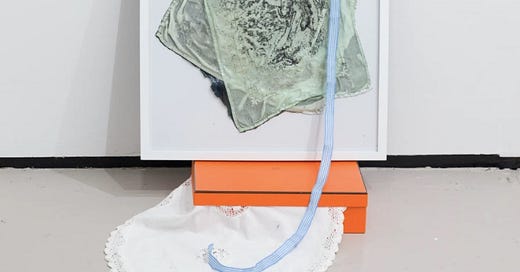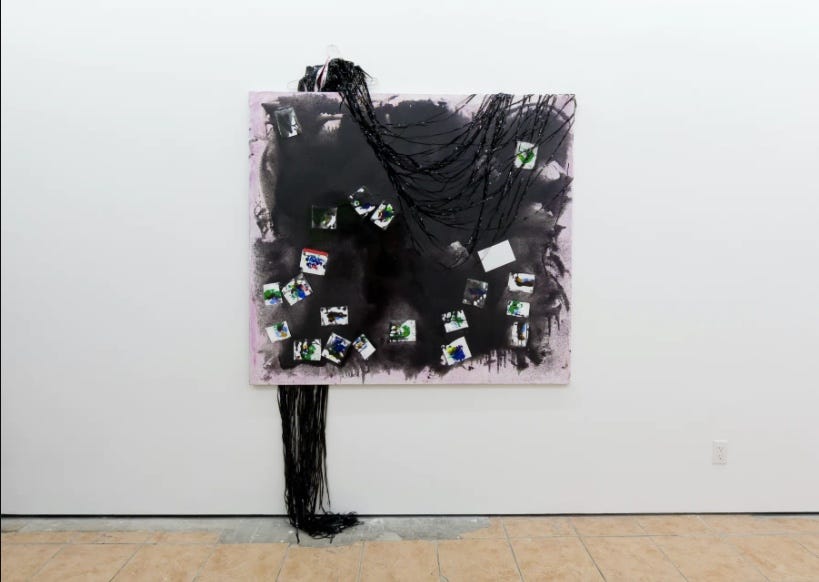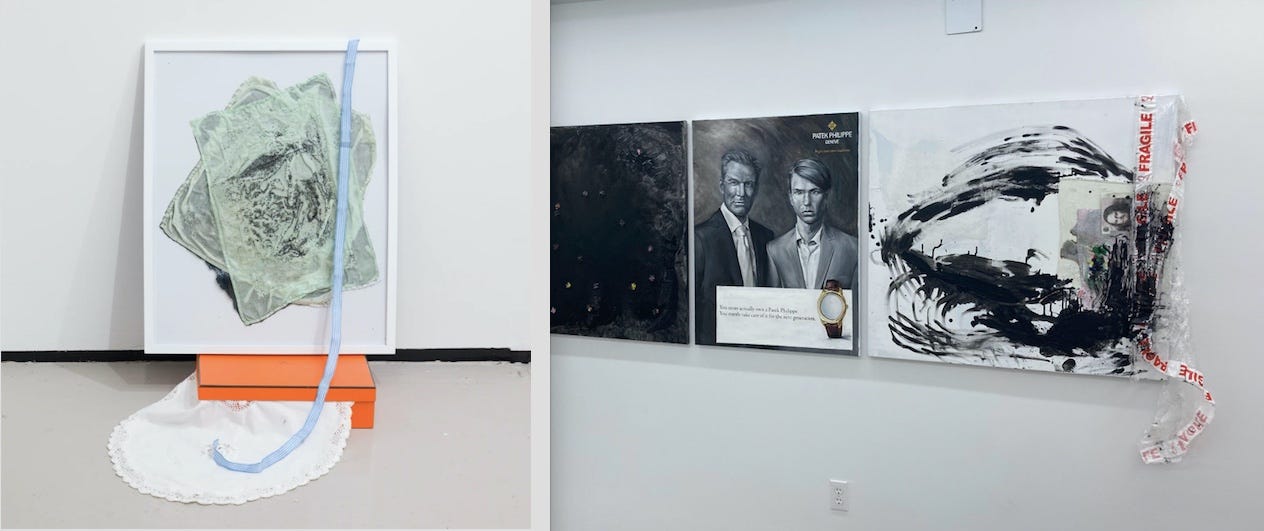Heirlooms and Gimmicks
Jasmine Gregory, Sianne Ngai, Vaudoisey-Creusefond, and a séance with the ghosts of one's youth
Readers: A weekly pace kills me and not in a good way. Would you prefer (A) regularly scheduled drips every two weeks, or (B) dispatches that arrive just, like, whenever but a little more often than that? Please let me know; hit the DMs or ssspigot@gmail.com.
Jasmine Gregory’s last solo exhibition was two years ago was at Karma International in Zurich, a show of dark, funny, fuckall figurative paintings that seemed to eat away at themselves the longer you stared at them. I came across the work online and had been intrigued, so I was glad when I saw she had a show coming up at King’s Leap in NYC.
Titled Heirlooms, Gregory’s new exhibition dissects the tangle of wealth, luxury, inheritance, history, and art history that inevitably sprawls into and over painting itself. Her new work takes a gameswomanly twist: the show is a set of ragged, smeary antipaintings with carefully chosen attached elements and humble(d) but not abject floor sculptures.
The large canvas Reflections in an Ikea Matryoshka Doll Mixtape (the titles slay throughout) features a messy black field over a light pink ground with dotty postcard-sized abstractions scattered across its surface. A mop of seeming cassette-tape innards drapes like prize bunting across the painting’s top edge—the mock-celebratory air reinforced with a red-white-and-blue “1st Place” ribbon—then falls behind the canvas to reappear vulgarly at the bottom and drag the floor. There’s a lot of subtle dialogue between the wall and the ground throughout the show, actually; the paintings, like Reflections, often have a flatbed-picture-plane thing going on, and the sculptures’ low placement makes their themes more pointed. The Hermes box in Estate Sale feels a lot different when it’s plunked on the ground as the support for some framed stained handkerchiefs.
A few paintings of Phillipe Patek watch-company ads recur, from a campaign centered on fathers and sons. At first I found them a little bald, almost old-fashioned, but they began to resonate as I spent time with them amid the other works. As you meet the gaze of the patrimonial duo staring out at you in Investment Piece (1), the chisel-faced whiteness and maleness of it all brings into focus the undertone of race that accompanies the more overt attack on class. Inheritance has a different quality when you’re not a generational Swiss gent but a Black American woman.
My favorite work is a sculpture titled As a Dog Eats Its Own Vomit, So Fools Recycle Silliness. (Strong agree.) Lit in a shallow blue-green, it’s like a delivery from a deranged drycleaner: wire clothes hangers dangle from a rack hung from the ceiling, but the plastic bags sheathe not suits and gowns but awkward swatches and pseudo-fabrics: flimsy pink gauze, a runner of ersatz silvery mail, a segmented airpack bag with its bubbles busted. Ribbon and tinsel decorate in spots, and black paint mars the bottom of one bag like you’ve dragged your just-pressed trousers through a mudpuddle on your way home. Here perhaps most explicitly Gregory nails the conflation of lifestyle accoutrements and objets d’art while taking her painting practice into another dimension.
Gregory is versatile and thoughtful quietly acerbic and and full of healthy skepticism about reward and success. Go check out the show; it ends Oct. 19.
Books
Sianne Ngai’s Theory of the Gimmick came out two years ago. I read chunks of it this summer for no particular reason; just trying to fill my brain with discourse beyond Twitter-grade punditry, I suppose. One of my hobbyhorses is the cultural obsession with cheap novelty, which seemed awful close to the idea of the gimmick to me, so I thought Ngai could possibly help me think through the subject.
Of course Ngai’s ideas are way more extensive than that. Her thesis is that the gimmick exposes the flawed relation between the amount of labor that goes into the something and the amount that thing is sold for. Surplus labor, if I understand my Marx correctly. (You may safely presume I don’t.) The gimmick can be critical of or complicit with this false relation, or both.
From this basic concept, Ngai elaborates a number of aspects of the gimmick. It has a strange relation to time: it can seem too early or too late (she deliciously uses the example of Google Glass); it does too much, Rube Goldberg style, or does too little. Ngai pulls a slightly tricky maneuver to treat the gimmick as a form of aesthetic judgement, so that labelling something a gimmick becomes an exercising of the faculty of taste. This allows her to get to Kant and opens to door to her analysis of books, movies, and art as opposed to, say, cryptocurrency.
In susbsequent chapters, Ngai touches on, among other subjects, the novel of ideas (Magic Mountain? Gimmick!) and the 2014 indie horror film It Follows, Torbjørn Rødland’s output and Stan Douglas’s 2002 Suspiria, a thirteen-channel myriad-hour Technicolor video synthesizing Marx and the folktales of the Brothers Grimm (it was made for Documenta, naturally) that repeats according to some complex algorithm such that it’s practically impossible that it would ever run the same way twice. Ngai failed to persuade me that Rødland’s deliberate mediocrity was any great virtue but otherwise the book is very good!
Wine
Bourgogne Côte d’Or Vaudoisey-Creusefond 2019. Totally ill-informed bias here but I hate pinot noirs from the godforsaken United States; they’re always getting shoved down your throat at Thanksgiving like flags on the 4th of July. I always find them one note and thin and too nasal for my tastes.
The French on the other hand make burgundy with the grape, which I won’t pretend to have learned more than a few years ago. This Bourgogne Côte d’Or goes through a progression unusual at this modest price; it starts out surprisingly rich, a little chocolatey and with a hint of oak, before entering into a fuller alcohol burn then you would expect since the wine is otherwise smooth and restrained. You do get that hyped pinot noir silkiness but only for an hour or so, at which time those equally vaunted herbal notes release more fully—sandalwood or something? After a few hours, it gets sweet and even richer like port lite that you’re sipping with a vanilla cigarillo. It even tastes good the next afternoon.
Music
Yeah, I’m old, but because I’m somewhat in denial of it and terrified of death I avoid its stalking horse, nostalgia, as much as possible. But because I was incapacitated all weekend thanks to an excessive Friday night—talk about not being what you used to be—I decided on the spur of the moment to go see Pavement on Sunday. Resale tickets were shockingly affordable, maybe due to the gruesome weather, maybe because adding that fourth show was one too many.
The hours leading up to the gig filled me with dread. In the end, as the band strolled through hits and obscurities, the experience was both satisfying and traumatic. I felt a great deal of sadness thinking about how rarely I talked to the various friends with whom I’d spent hours listening to their music years ago; I felt shame at the degree to which I’d parsed Malkmus’s lyrics in my youth. I felt horror at the truly insubstantial ways I waste my spare time now. To dilute the experience, I kept taking myself out of the moment by texting. One friend reminded me that not only had I once interviewed the band (ugh), I’d worn a necktie.
Anyway, I avoided any breakdowns or even tears and enjoyed myself in a complicated way. I ran into Jessica Hutchins, a very good artist who happens to be partnered with Malkmus, and so we got to hang out afterwards. This was a relief, since my millennial lady companion had already pointed out that dating a Gen X man was pretty pointless if they couldn’t get you backstage at the Pavement reunion show.
Per some laughable Covid provision, “backstage” turned out to be the parking lot. In the chill drizzle, I kept a respectful distance from the band members, but there were a few old randos whom I recalled dimly or well and we chatted and drank Modelos from a cooler. It made me feel connected to other people once again and blotted out my horror at aging for a while, which is why I socialize, which may be why I write criticism even. It’s a conversation; it implicates other people in a way that fiction doesn’t—that’s why I’ve sucked at writing novels. Other people are always for me a raw but beautiful distraction.
“Frontwards” was always my favorite song, if I had to pick one, and they played it Sunday. You can’t find a live version that isn’t fucked up one way or another, which couldn’t be more appropriate. Here’s an uptempo one from Minnesota in 1992.








